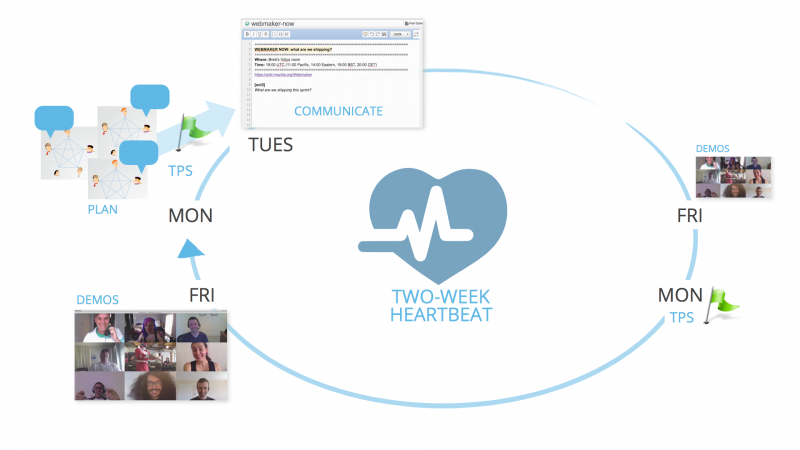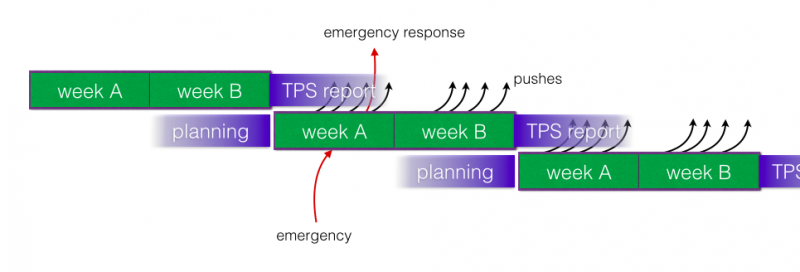Webmaker/TPS: Difference between revisions
< Webmaker
Jump to navigation
Jump to search
| Line 21: | Line 21: | ||
** '''There are planning phases at the beginning of each Heartbeat.''' We do planning and communicating up front, then let take agency to get stuff done. | ** '''There are planning phases at the beginning of each Heartbeat.''' We do planning and communicating up front, then let take agency to get stuff done. | ||
** '''We report large progress bi-weekly'''. At the end of each Heartbeat, we take stock, demo our best work, and use what we learned to inform the next cycle. | ** '''We report large progress bi-weekly'''. At the end of each Heartbeat, we take stock, demo our best work, and use what we learned to inform the next cycle. | ||
=How it works= | =How it works= | ||
The life-cycle of a Heartbeat: | The life-cycle of a Heartbeat: | ||
Revision as of 16:03, 3 October 2014

TPS
- What? Tactical Priorities Syndicate. MoFo leaders who help translate our strategic goals into tactical priorities each two-week cycle.
- Why? A more agile working style, distributed leadership, and short, time-bound initiatives that tie back to our quarterly and yearly goals.
- Who? David Ascher, Paul Johnson, Chris Lawrence, Geoffrey MacDougall, Cassie McDaniel, Ben Moskowitz, Andrew Sliwinski, Matthew Thompson, Michelle Thorne, Simon Wex (tps [at] mozillafoundation [dot] org)
- How? Through weekly TPS meetings. In a collaborative production cycle we design together.
- When? The TPS meets every Monday (time TBD)
Links
- Notes https://etherpad.mozilla.org/tps
- Project Brief (template) (draft). A standard project brief template (aka "TPS Report") for teams to use. Outlining the project's goal, roles and tasks.
- Webmaker wiki. Links to project briefs, key priorities for the current Heartbeat,
- List of active Webmaker projects and modules. (coming soon)
Production cycle
- We work in two-week "Heartbeat" cycles. A well-designed, two-week production cycle helps us do collaborative production better. Working across teams with the right mix of cohesion, empowerment and communication.
- The TPS helps design and optimize this cycle. Meeting at the beginning and mid-point of each Heartbeat to prioritize and allocate resources. More details taking shape here.
- Key points:
- Not everything requires two weeks. Work gets shipped whenever its done, not just at the end of the sprint. And emergencies get handled as they deserve.
- There are planning phases at the beginning of each Heartbeat. We do planning and communicating up front, then let take agency to get stuff done.
- We report large progress bi-weekly. At the end of each Heartbeat, we take stock, demo our best work, and use what we learned to inform the next cycle.
How it works
The life-cycle of a Heartbeat:
- Plan on Monday. Small groups and cross-functional teams get together on the first Monday of each Heartbeat. To discuss what their team wants to get done together over the next two weeks. The TPS then meets to review everyone's proposals.
- Communicate on Tuesday. The entire Webmaker tribe gathers on Tuesday. To review and talk about about the finalized list of priorities set by the TPS. Everyone leaves with a shared sense of what we're all working on together that Heartbeat.
- That's it! The rest of the two weeks are your own. You can add on additional meetings or stand-ups as you and your manager see fit. The TPS meets at the mid-point to look ahead and ensure we're on track. And we get together at the end of the cycle to demo and celebrate what we got done.
The result: Fewer meetings, smarter communication, more time to get stuff done. Much more detail on our Heartbeat production cycle here.
Inputs and Outputs
- How to get stuff into the Heartbeat production queue.
TPS Roadmap
[oct3]
- (milestone)
[oct17]
- (milestone)
[oct31]
- (milestone)
[nov14]
- (milestone)
[nov28]
- (milestone)
[dec12]
- (milestone)

